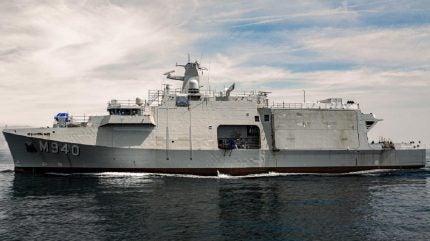
The first of the joint Dutch-Belgian mine countermeasure vessels (MCMV) has begun sea trials, with the BNS Oostende departing Concarneau on 17 July 2024, to start performance tests ahead of its delivery in summer 2025.
The bilateral MCM programme is being led by Belgium Naval & Robotics, a consortium formed by Naval Group and Exail, and involves Kership (a joint venture between Piriou and Naval Group) as industrial prime contractor.
During this first sea trial, the ship’s performance will be put to the test, in particular its propulsion and navigation systems. Several trials will then follow to test all the systems, according to an 18 July release from Belgium Naval & Robotics.
Clémence Picard-Destelan, Naval Group’s onboard manager for this test campaign, said that the tests were “symbolically a very powerful moment” following the start of construction of the first-in-class MCMV in 2021.
Seven ships under construction
The BNS Oostende was launched on 29 March 2023, followed by the second ship in the series, the Vlissingen, for the Royal Netherlands Navy, on 19 October 2023, and the Tournai on 24 June 2024.
The fourth ship in the series, the Scheveningen, is due to be launched in December 2024.
Belgian-Dutch MCMV characteristics

In total, seven of the 12 ships in the series are currently under construction, at various stages of completion. Delivery of the Oostende is scheduled for summer 2025 in Zeebrugge, Belgium, with the other ships-in-class staggered until mid-2030.
French industry leads joint Belgian-Dutch MCMV project
In May 2019, Belgium Naval & Robotics was awarded a €2bn ($2.4bn at the time) contract to deliver 12 MCMVs, six each for the Belgian and Netherlands navies, as part of the MCM capability replacement programme.
The new vessels will replace the Tripartite-class minehunters operated by both countries for the past 30 years. Under the workshare, Naval Group is responsible for ship design, overall integration, testing and commissioning of the mission system.
The ships are built and assembled by Piriou, under the industrial project management of Kership, a joint venture between Naval Group and Piriou.
Meanwhile, Exail is responsible for the development of the autonomous surface and underwater vessels (AUV/UUV) that perform the sweep, detect, and neutralise elements of the MCM mission.
Composition of the MCMV drone fleet
Belgium Naval & Robotics state that the programme for the Belgian and Dutch navies “represents a complete paradigm shift” in the way that the MCM mission is conducting, which will see the USV and AUVs embarked on the ‘mothership’ performing the so-called dull, dirty, and dangerous sweep and detection of sea mines, enabling the BNS Oostende and its sister ships to remain at a distance.
Using a fleet of embarked MCM drones will greatly improve the area of water being covered by a single vessel, enabling efficiencies and improved safety for the crewed elements of the MCMV capability.
The embarked drone payload includes: Exail UMISOFT System, two Exail Inspector 125 USVs, three A-18 AUVs equipped with Exail UMISAS 120 sonar, two towed sonars (T-18 equipped with Exail UMISAS 240 sonar), two Mine Identification & Disposal Systems (MIDS) systems (Exail Seascan and K-Ster C), two UAVs (UMS Skeldar’s V200), one Exail influence mine sweeping system integrating 5 CTM magnetic modules, and one Patria acoustic module.







